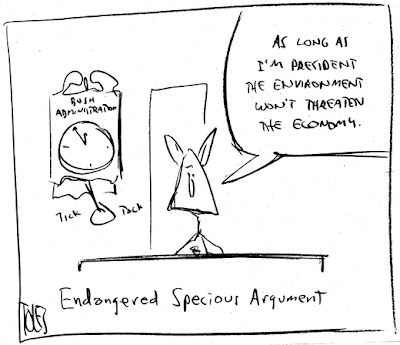 Today is Earth Day, the occasion of special events in honor of the environment. Many websites will have suggestions for things to do. Companies will seek to advertise their environmental bona fides through partnerships with conservations organizations or new lines of "green" products.
Today is Earth Day, the occasion of special events in honor of the environment. Many websites will have suggestions for things to do. Companies will seek to advertise their environmental bona fides through partnerships with conservations organizations or new lines of "green" products.
David Fahrenthold has a great article on the contemporary contrast between environmental goodwill and real-world results in today's Post.
Since the first Earth Day, in 1970, environmental laws have helped clean up rivers across the country, including the once-abysmal Potomac. The banning of the pesticide DDT in the 1970s helped bring back the bald eagle, which has now re-colonized Washington's urban core.Part of the problem is that too much emphasis is put on conservation as a personal virtue. Our most intractable environmental problems are caused by systemic practices, so what we need is systemic change. Small numbers of individuals cannot do this by themselves. You cannot take the subway to work or school if there is no subway. Individuals do not award billion-dollar subsidies for destructive agricultural practices. Individuals do not regulate the power industry or set fuel efficiency standards. Real systemic change will not happen until we have political and business leaders who are willing (or feel compelled) to effect it. This may happen in the near future, but a lot of forces stand in the way of change. There is a role for concerned individuals here, to put pressure on governments and businesses and choose leaders wisely.
But even with "green" becoming nearly as common as "lite" on supermarket labels, some environmental historians say they wonder what it is all adding up to. They worry that the activity will give the illusion that major environmental problems are being solved -- when, in fact, many remain intractable....
Here, the dynamic has played out with the region's best-known environmental cause: the Chesapeake Bay. The nonprofit Chesapeake Bay Foundation had 5,700 members in 1978. Today, it has more than 190,000, most of them gaining membership either through donations or volunteer work.
But still, the bay is not much better.
In the meantime, individual conservation efforts certainly have their place. Birders can do plenty of things to help the birds we love and reduce our contribution to global warming. Here are a few.
- If you own property, convert as much as you can to wildlife habitat, following the suggestions of Audubon at Home and the National Wildlife Federation. At the very least, do not use artificial fertilizers and pesticides (or hire landscapers who do). Runoff from these chemicals harms our bays and estuaries such as the Chesapeake Bay or Long Island Sound.
- Drink shade coffee instead mass-market coffee to preserve winter habitat for migratory birds. (See the informative Coffee and Conservation blog for more about this.)
- Become politically active. Birder's World suggests contacting legislators about some current issues, including the destructive border wall. Get involved in local environmental issues as well.
- Reduce electric power consumption. Much of our electricity comes from burning coal, the extraction of which destroys habitat.
- Bird locally and use public transportation where possible.



